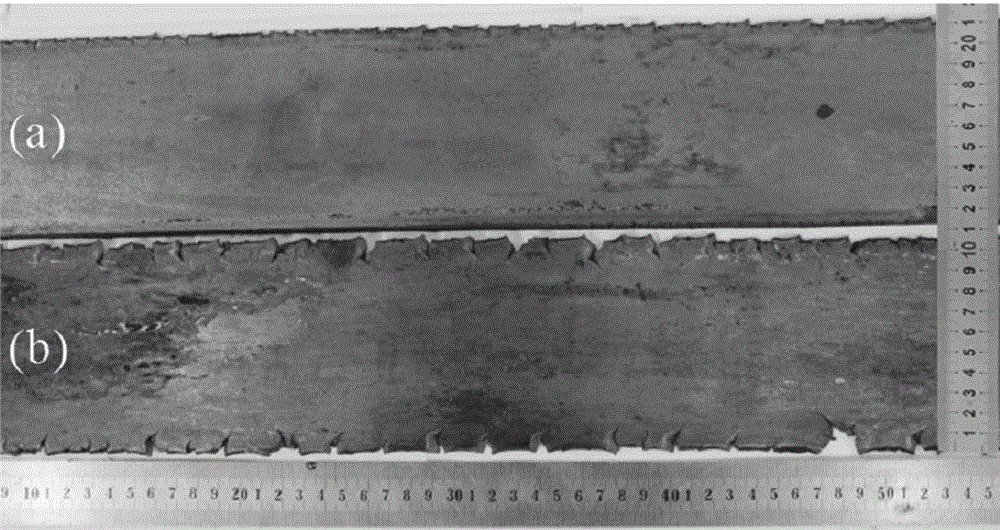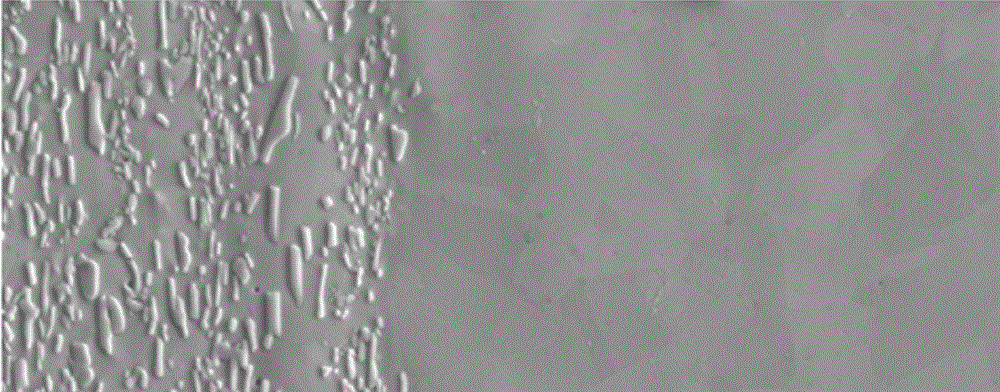Method for improving hot-working performance and room-temperature plasticity of high-boron stainless steel
A stainless steel and hot working technology, applied in the field of metallurgical materials, can solve problems such as poor hot working performance and edge cracking, and achieve the effects of short production process, delayed plastic instability, and excellent room temperature plasticity.
- Summary
- Abstract
- Description
- Claims
- Application Information
AI Technical Summary
Problems solved by technology
Method used
Image
Examples
Embodiment 1
[0027] Molten steel is smelted, and high-boron stainless steel ingots are obtained by die-casting. Its chemical composition is Cr18.5%, Ni 13.9%, Mn 1.81%, B 2.11%, C 0.05%, and the rest is Fe and unavoidable impurity elements;
[0028] Use sawing machine, milling machine and grinding machine to cut and surface finish the high boron stainless steel ingot to obtain a high boron stainless steel billet with smooth and bright surface and roughness Ra<0.8um;
[0029] Use sawing machine, milling machine and grinding machine to cut and finish the surface of austenitic stainless steel plate to obtain austenitic stainless steel plate with smooth and bright surface and roughness Ra<0.8um, and its length and width are the same as those of high boron stainless steel billet ; Among them, the chemical composition of the austenitic stainless steel plate is Cr 18.3%, Ni 13.9%, Mn 1.81%, C 0.05% by mass percentage, and the rest is Fe and unavoidable impurity elements;
[0030] Use acetone and...
Embodiment 2
[0035] Method is with embodiment 1, and difference is:
[0036] (1) The chemical composition of high boron stainless steel ingots is Cr 17.0%, Ni 15.0%, Mn 1.5%, B2.25%, C 0.07% by mass percentage, and the rest is Fe and unavoidable impurity elements;
[0037] (2) The chemical composition of the austenitic stainless steel plate is Cr 17.0%, Ni 15.0%, Mn 1.5%, C0.07% by mass percentage, and the rest is Fe and unavoidable impurity elements;
[0038] (3) The ratio of the thickness of each austenitic stainless steel plate to the thickness of the high-boron stainless steel billet is 1 / 2, and then welding is carried out along the periphery of the contact surface of the billet under the vacuum condition of pressure P<5.0Pa to form an uninterrupted welding seam to obtain a composite blank;
[0039](4) Put the composite billet into the heating furnace and raise the temperature to 1150°C with the furnace, and keep it warm for 20 minutes, and then perform 10 passes of hot rolling. The h...
Embodiment 3
[0042] Method is with embodiment 1, and difference is:
[0043] (1) The chemical composition of the high-boron stainless steel ingot is Cr 19.5%, Ni 12.0%, Mn 2.0%, B 1.75%, C 0.04% by mass percentage, and the rest is Fe and unavoidable impurity elements;
[0044] (2) The chemical composition of the austenitic stainless steel plate is Cr 19.5%, Ni 12.0%, Mn 2.0%, C0.04% by mass percentage, and the rest is Fe and unavoidable impurity elements;
[0045] (3) The ratio of the thickness of each austenitic stainless steel plate to the thickness of the high-boron stainless steel billet is 1 / 10, and then welding is carried out along the periphery of the contact surface of the billet under the vacuum condition of pressure P<5.0Pa to form an uninterrupted welding seam to obtain a composite blank;
[0046] (4) Put the composite billet into the heating furnace and raise the temperature to 1140°C with the furnace, and keep it warm for 40 minutes, and then carry out 5 passes of hot rolling...
PUM
| Property | Measurement | Unit |
|---|---|---|
| thickness | aaaaa | aaaaa |
| thickness | aaaaa | aaaaa |
| elongation | aaaaa | aaaaa |
Abstract
Description
Claims
Application Information
 Login to View More
Login to View More - R&D
- Intellectual Property
- Life Sciences
- Materials
- Tech Scout
- Unparalleled Data Quality
- Higher Quality Content
- 60% Fewer Hallucinations
Browse by: Latest US Patents, China's latest patents, Technical Efficacy Thesaurus, Application Domain, Technology Topic, Popular Technical Reports.
© 2025 PatSnap. All rights reserved.Legal|Privacy policy|Modern Slavery Act Transparency Statement|Sitemap|About US| Contact US: help@patsnap.com



